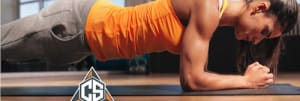"30 Day Ab Challenge" AKA The Back Pain Challenge

It’s approaching beach body season, and the vultures of the fitness industry are circling!
I know this because I recently saw on Facebook where a friend joined the “30 day Ab Challenge”. Immediately I cringed at the thought of the thousands of lumbar spines that are heading down the repetitive injury road. A road that promises a destination of skinny waists and six packs, but dead ends in bulging discs and painful low backs.
So, Let’s assume the goal with this program is to increase the core strength, and the campaign targets those needing a jump-start (aka sedentary people). With this in mind, here is a breakdown of the program.
The Challenge is a combination of 4 exercises; Sit-ups, curl-ups, planks, and leg lifts. You perform an increasing amount of these 4 exercises on a daily basis as you “progress” in strength. There is a rest day every 4th day.
Let me explain why this is a recipe for chronic injury.
First, forced flexion in any “core exercise” is an attempt to work the rectus abdominus (commonly known as the “six pack” muscle), and because this is a single plane exercise (no rotation or lateral bending involved), you are working a very isolated portion of the “core”. It’s no more a “core” exercise than bicep curls are a “chest” exercise (the point here being the pecs do contract when doing a curl, but you wouldn’t consider that a chest exercise!).
So without even getting into the detrimental effects that repetitive flexion and extension can have on the lumbar spine, the first two exercises at best are redundant and miss the boat on core strengthening. A good core routine hits the entire cylinder of the core including the front, back, and sides.
With that in mind, I’ve changed this routine to truly help build a strong core.
Instead of Crunches or traditional Sit-ups, Try and perform the Janda Sit Up or progressions of an exercise called Dead Bug.
https://www.youtube.com/watch?v=gnClyN1q4KQ (Janda Sit Up)
https://www.youtube.com/watch?v=nfbTirSVKLM&t=39s (deadbug)
The plank can be a very good exercise and there are many challenging variations, all of which challenge scapular, pelvic, and lumbar stability. However, this is rarely performed correctly. Most people do not focus on scapular stability and have little to no glut activation, both of which are vitally important components to the core. Watch these short videos about the proper way to perform different plank variations. Take the progressions very slow and be mentally present when you preform them, there is more to this exercise than just “being rigid”.
https://www.youtube.com/watch?v=ktOf5mSTYVk (Hollow Body Plank)
*this is an over exaggeration of what the shoulders shoulder be doing during a normal plank. The key here is to prevent body from sagging off the shoulder blades.
https://www.youtube.com/watch?v=Z9Cou_pgVqY&t=12s (Side Plank)
Leg lifts can also be a good exercise to perform when done correctly, but they are HARD to perform correctly. Likely what will happen when the vast majority attempt a leg lift, is excessive lumbar (or low back) extension courtesy of the psoas or hip flexor muscles. Repeating this over and over will damage the posterior joints of the lumbar spine, as well as weaken the discs.
In order to know if you are performing the leg lift correctly follow these simple steps.
First, lay on your back with your hands placed in the small of you back and legs flexed to 90 degrees so the soles of your feet are pointed towards the ceiling. As you tighten down the gluts and core, you should feel your lumbar spine create pressure onto your hands.
Keeping the abdomen and gluts very tight, slowly lower your legs until you feel the pressure start to release off your hands. This is the point where your core fails and you start to be pulled into the danger zone.
Try This Instead: Starting in the previously described position, lower the legs until your lumbar spine just starts to extend (you start to feel less pressure on your hands). Hold this position for 3-5 seconds, then bring your feet back up to start position. Repeat this up to 5-10 times (or for a total of 90 seconds) but not to total failure. Each rep should take about 5 seconds.
If you insist on doing leg lifts, try this variation instead. The offset weight in the upper body increases the core demand and stabilizes the spine.
https://www.youtube.com/watch?v=WOn7xJuGim0
And don’t Neglect the Posterior Chain! Yes, the glutes are part of your core due to their role in stabilizing the spine. The goal with adding this to the core is trying to get engagement of the glutes and low back musculature without sacrificing spinal alignment. To accomplish this, one of my favorite drills is call the Birddog. Not the Jane Fonda butt kick style birddogs, but the athletic challenging kind…
https://www.youtube.com/watch?v=V49HR3buoYs (Birddog)
The New Program:
Accumulate 60 seconds worth of solid holds (or slow controlled reps) of one drill in each section. Perform 3 straight days and rest on the 4th. Add 10 seconds worth of holds each time you start a 3 day cycle. You should be able to get about 7 1/2 cycles in the month so by the end of this you’ll be hitting more than 2 minutes of each drill! Feel free to add another round if you feel like you need more of a challenge.
Again, these comments are in assumption that most people engaging this 30 day ab challenge are doing so with a lower level of fitness. Jumping into a program like the one described in the beginning of this rant is a recipe for disaster. For those of you who don’t consider yourself a beginner in your fitness goals, there are better, more advanced exercises to be doing besides these exercises.
Don’t get sidelined by injury by blindly jumping on fitness bandwagons like this. If you need guidance, get it from a trusted source!

